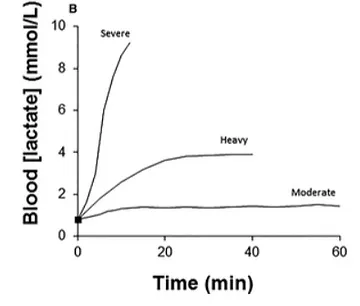Lactate is a commonly used term in endurance training, and generally, we use the term lactate when referring to “threshold” training or super hard efforts.
Measuring the lactate concentration in our blood can give us insight into how physically demanding a task is. The lactate concentration in our blood acts as a proxy for the rate of anaerobic metabolism occurring in the working muscles.
I feel bad for the lactate molecule because everyone blames it for being bad, but it’s trying to help you. Lactate removes positively charged hydrogen ions from your muscles cells to maintain the pH, or acid/base balance, so you can maintain normal function.
Lactate Threshold is Important
The lactate threshold is an important physiological reference point because it represents the transition between heavy and severe exercise intensities (Figure 1. Jones 2019).
Severe exercise is at no point steady-state and therefore the duration you can exercise above your lactate threshold is limited to the rate lactate is accumulating. However, below your lactate threshold, you can reach a steady-state and exercise for prolonged periods. If we know your threshold, we can easily define unsustainable and sustainable pace/power outputs. Knowing your sustainable outputs is particularly important for endurance events around 1-5hrs.
The “Step Test” is Great BUT…
Traditionally, lactate testing has been done via a “step test”. A step test measures your lactate concentration at increasing speeds or power outputs. Usually, each step is 4-5min long and will start at an easy pace/power and progress until you cannot hold the pace/power for the entire 4-5min. Using the data from a step test, we can plot your “lactate curve” and determine your “lactate threshold”. If you do these step tests every couple of months, you can track your fitness by looking at how sharp your curve is and the pace/power of your threshold.
While the step test is good for looking at many different outputs in one single test, generally, we’re only interested in one metric; your lactate threshold. Trying to find your lactate threshold on a curve plotted from 5 or 6 points can often lead to error.
The maximal lactate steady-state test is an alternative to the lactate step test for determining your lactate threshold. Not only is the MLSS test a more accurate method of testing, but it is easier to complete in the field and has more real-world applications.
How to Test Your Maximal Lactate Steady State
“The MLSS is conventionally derived from a series (typically 4–5) of 30 min continuous exercise bouts, completed on separate days, at different but constant running speeds or power outputs; blood [lactate] is measured at rest and after every 5 min of exercise and the MLSS is defined as the highest speed or power output that does not result in a rise of blood [lactate] of greater than 1 mmol/L between 10 and 30 min (Jones and Doust 1998).”
Because of cost and time constraints, I opt for just testing at 10min and 30min. It may not give as much insight, but it’s a lot easier to complete out in the field.
Warm-up 15min
10min @ a power output slightly lower than FTP or Critical Power (CP)
Test Lactate – #1
20min @ the same power output as the first 10min
Test Lactate – #2
Test More Than Once
While I don’t think 4-5 test are necessary, you’ll still want to do more than one to find a steady-state and non-steady-state pace/power output. Using my MLSS as an example. I averaged 3:38min/km (355 Watts) and my lactate went from 4.9 – 13 mmoL, indicating that my pace/power is not steady-state, and if I tried to run a half marathon or marathon at that pace/power it wouldn’t have ended well. I know this for a fact. For me, I don’t need to guess or wonder if I could hold under 3:40min/km (>360 Watts) for my next half marathon because it’s clear that I’m already accumulating lactate after 30min. I also know that if I’m wanting to run a “tempo” or “threshold” workout, I should be running faster than 3:40min/km (355 Watts), otherwise, I’m overloading that session.
From here, I can do another MLSS in a few days aiming to run 2-3% slower (3:45min/km or 345 Watts) and see if that pace/power is steady-state. As it turns out, I have a club 10km race in a few days, and then I’ll do my 1km – 5km critical power test, and then I’ll re-do my MLSS test so I can compare a few different methods of threshold determination.
For more information on my 1 & 5 method click HERE.
To view the run on Strava click HERE.
Keep an eye out for my follow up tests and blogs (and vlogs!). If your a coach or athlete wanting help with your lactate testing protocols, I can run tests in New Zealand and consults online.


